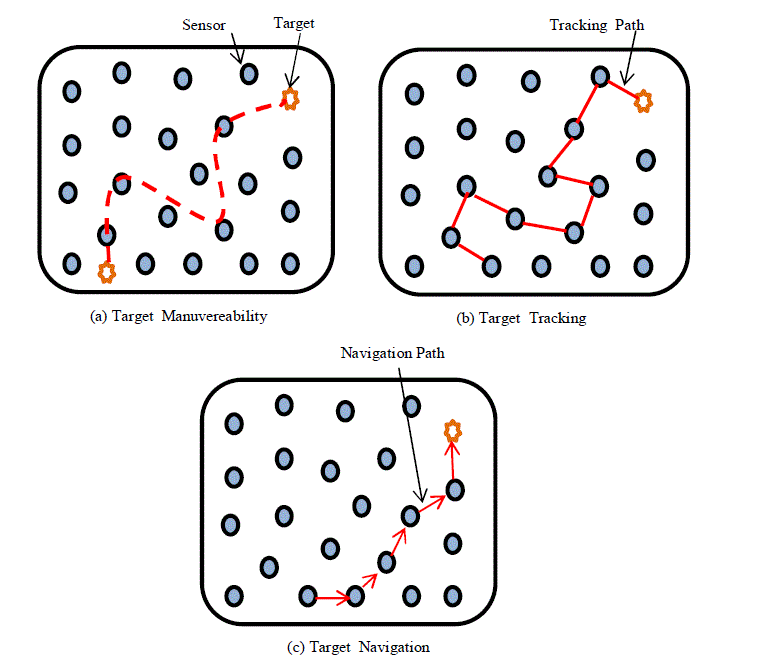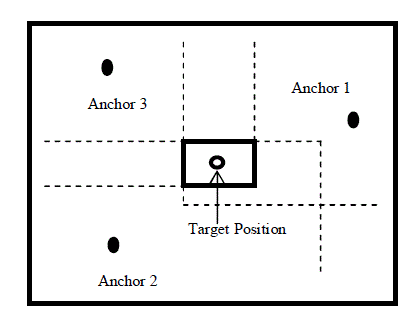Keywords
|
| Wireless Sensor Networks, Target Movement Prediction Algorithm, Topological Preserving Maps, Adaptive Weighted Target Tracking. |
I. INTRODUCTION
|
| Wireless technology is rapidly improving all around the world. In future thousands of self-organized nodes will be used in many fields of Wireless Sensor Networks based applications. Because of the portability, decrease in cost, flexibility and the ease of instantaneous network installation are the keys to WSN’s success. In most cases the usage of WSN technology lies in military applications, however nowadays also many civil applications for WSNs exist. Some of them are: Instant communication infrastructure for Disaster recovery, intelligent traffic system, Intrusion detection in Facility management, Precision agriculture, Monitoring in medicine and healthcare, intelligent buildings, Identifying/Tracking in Logistics and data collection in the animal behavior analysis. |
| So WSN has a diversity of applications wherever it is essential to monitor an environment or the subjects within it. The type of information gathered and accuracy is dependent on the function of the network that is what the WSN has to monitor. |
| In this paper, we are primarily interested in object tracking by considering both localization of the target and navigation of mobile sensors. In particular our main objectives are to prediction of serious movements of a moving target and quantitatively improving the accuracy of the mobile sensor navigation in wireless sensor networks without any physical measurements. |
II. TRACKING AND NAVIGATION
|
| Localization in WSN is to find the terrestrial positions of sensors in a wireless sensor network. Determining the accurate location information of sensors is an important and crucial issue for WSN operations and its applications for several reasons. Because most of the information measured from sensors are only meaningful when they are attached to the location evidence of the corresponding sensors. |
| However, in most of the applications, sensor nodes are deployed without their location information being known in the prior, so there is no supportive set-up available to find them after deployment. It is therefore compulsory to find some methodologies for locating and tracking the position of each sensor in wireless sensor networks after their deployment. |
III. LITERATURE REVIEW
|
| The necessity of target tracking and sensor routing arises when a moving object does not pursue a predictable path. Number of existing target localization approaches based on various dimension models such as received signal strength (RSS) – is a generic metric based on the level of power being received by the receiver, time of arrival (TOA)-deals the relationship between transmission time and distance when signal propagation speed is well-known, time difference of arrival (TDOA) – based on signal time difference between the source and three or more destinations, signal angle of arrival (AOA) – is a methodology for finding the direction of signal propagation, and their combinations [1], [2].Kalman filter introduced a predictive location tracking algorithm for object tracking with limited signal sources [3]. Distributed mobility management scheme for object tracking was investigated by Zou and Chakrabarty [4].The joint problem of target localization and manoeuvrability of sensor navigation based on a TOA measurement model was proposed by Enyang Xu and Zhi Ding [5]. |
| Topology Preserving Maps (TPMs) is an advanced technique, which preserve the neighbourhood information and generates network maps from Virtual Coordinate without the requirement of geographical distance [6]. Virtual coordinates offer a cost-effective alternative to physical coordinates based routing in self-organized large-scale WSNs. The number of anchor nodes and their placement for a network play a vital role in VCS based routing [6][7][8]. H. Yang, and B. Sikdar proposed the Distributed Prediction and Tracking (DPT) protocol for efficiently tracking [9]. Y. Xu, J. Winter and W. C. Lee studied reporting mechanisms in object tracking sensor networks and proposed a dual prediction based approaches for energy aware reporting [10].Using topological coordinates the TCTP algorithm developed by Yi Jiang et al. [11] to track and predict the mobility of sensor node without any geographical measurements. This paper proposes a Target movement prediction algorithm (TMPA) based on min-max methodology to estimate the target location using topological coordinates and topology preserving maps. Our main contribution is to improve the accuracy in sensor navigation and reduce the path detection errors by implementing the Adaptive weighted target tracking methodology. |
IV. ANALOG MEASUREMENT MODELS
|
| Routing in WSNs is interesting due to the fact that these networks are created in an instant, and consequently it does not depend on the availability of the infrastructure, such as routing devices in wired networks or access points in predefined wireless networks. Though, a plenty of geographic position based algorithms have been proposed based on different techniques like received signal strength measurement (RSS), angle-of-arrival (AoA), time difference of arrival (TDOA), triangulation, time of arrival (TOA) etc., it still remains a hard problem. |
| Implementing sensor nodes with GPS is expensive and infeasible in most of the applications due to energy constraints. In repetition, RSSI based measurements contain signal propagation, noise on the order of distance and clock synchronization between source and destination causes error in TOA, though TDOA overcomes the need of time sync between two nodes the synchronization demand for different nodes within the network still remains. |
| These analog signal based dimensions encounter uncertainties and complexities in terms of poor line-of-sight, interference, scattering, and multipath fading, which are hard to overcome in many indoor and outdoor WSNs applications. Furthermore, geographical coordinate based localization is infeasible or not accurate in certain environments. Encountering the importance of tracking and accuracy will result in simple sensor nodes and less complexity algorithms, and facilitate large-scale implementation of WSNs. |
V. VIRTUAL COORDINATES
|
| This paper proposes a solution which does not need an initialization of infrastructure. This implies that it is starting to serviceable as quick as the network is implemented. The sensor nodes use virtual coordinates instead of real coordinates which are informed throughout the lifetime of the network. No need of network-wide frequent updates and the system is exceptionally robust against nodes performing and link dynamics. Implementation of virtual coordinates eliminate the dependency rely on costlier anchor nodes. |
| Virtual coordinate routing enables high reactivity, robustness, energy efficiency and overhead-free relocation in large-scale WSNs. In virtual coordinate systems any node can be identified as an anchor node with no additional requirements. The number of anchor node determines the dimension of the network. Connectivity based routing make VCS an attractive method for positioning the tracking the target node. |
| TPM preserves the neighbor node information and provide the biased version of node maps using the conjunction of topological coordinates and virtual coordinates. TPM overcomes the issues related to the geographic routing and virtual coordinate routing. |
VI. TARGET MOVEMENT PREDICTION ALGORITHM
|
| A novel target maneuverability tracking scheme called target movement prediction algorithm (TMPA), which illustrates the effectiveness of the SDP and TPM, is proposed. Semidefinite Programming relaxation yields higher optimization solutions when the given measurements are noisy. To lighten this problem, we adopt thoughts from a reduction in network dimensionality and use internal enhancement to improve the accuracy of the prediction ratio. Our distributed method is derived so as to achieve the gains of both the centralized and distributed standards in position estimation, by not being fully distributed. |
| Finally, a novel concept of error reduction methodology named adaptive weighted target tracking (AWTT) introduced. Comparatively the error due to the routing path propagation is often much greater than issues due to node sensing. As shown in Figure:2 the new method is to develop a bounding box initialized from the known location vector (Ai, Bi) and distance metric di. The estimated target position is calculated as the middle of the intersection of these boxes and additionally the final location is derived as the average of both corner anchor node coordinates. |
VII. CONCLUSIONS AND FUTURE DIRECTIONS
|
| We study the issues in object tracking and navigation accuracy in wireless sensor networks. Based on a more general VCS model, semidefinite optimization is used for the prediction. Our simulation results indicate that positioning and navigating without any real coordinate information, using TCs is effective. Proposed Target Movement Prediction Algorithm enhances the accuracy and provides the best capability to navigate the target. Future work involves with investigation of the algorithm with the objective of obtaining the finest prediction ratios. |
| |
Figures at a glance
|
 |
 |
| Figure 1 |
Figure 2 |
|
| |
References
|
- A.H. Sayed, A. Tarighat, and N. Khajehnouri, “Network-Based Wireless Location: Challenges Faced in Developing Techniques forAccurate Wireless Location Information,” IEEE Signal Processing Magazine, vol. 22, no. 4, pp. 24-40, July 2005.
- N. Patwari, J.N. Ash, S. Kyperountas, A. Hero, R.L. Moses, and N.S. Correal, “Locating the Nodes: Cooperative Localization in WirelessSensor Networks,” IEEE Signal Processing Magazine, vol. 22, no. 4, pp. 54-69, July 2005.
- P.H. Tseng, K.T. Feng, Y.C. Lin, and C.L. Chen, “Wireless Location Tracking Algorithms for Environments with Insufficient SignalSources,” IEEE Trans. Mobile Computing, vol. 8, no. 12, pp. 1676- 1689, Dec. 2009.
- Y. Zou and K. Chakrabarty, “Distributed Mobility Management for Target Tracking in Mobile Sensor Networks,” IEEE Trans. MobileComputing, vol. 6, no. 8, pp. 872-887, Aug. 2007.
- Enyang Xu and Zhi Ding, “ Target Tracking and Mobile Sensor Navigation in Wireless Sensor Networks,” IEEE Trans.MobileComputing, vol.12, no. 1, pp. 177-195, Jan. 2013.
- D. C. Dhanapala and A. P. Jayasumana, “Topology Preserving Maps from Virtual Coordinates for Wireless Sensor Networks,” Proc. 35thIEEE Conf. on Local Computer Networks, 2010, pp. 136–143.
- D. C. Dhanapala and A. P. Jayasumana, “Geo-Logical Routing in Wireless Sensor Networks”, Proc. 8th IEEE Conf. on Sensor, Mesh andAd Hoc Communications and Networks (SECON), 2011, pp. 305 – 313.
- K. Liu and N. Abu-Ghazaleh , “Aligned Virtual Coordinates for Greedy Routing in WSNs,” Proc. IEEE Int. Conf. on Mobile Adhoc andSensor Systems, 2006, pp. 377–386.
- H. Yang, and B. Sikdar, “A Protocol for Tracking Mobile Targets Using Sensor Networks,” Proc. First IEEE Int. Workshop on Sensoretwork Protocols and Applications, 2003, pp. 71 – 81.
- Y. Xu, J. Winter and W. C. Lee, “Dual Prediction-Based Reporting for Object Tracking Sensor Networks,” Proc. First Int. Conf. onMobile and Ubiquitous Systems: Networking and Services, 2004, pp. 154 – 163.
- Yi Jiang, Dulanjalie C. Dhanapala and Anura P. Jayasumana. “Tracking and Prediction of Mobility without Physical DistanceMeasurements in Sensor Networks,” Proc. IEEE International Conference on Communications, Budapest, Hungary, June 2013
|